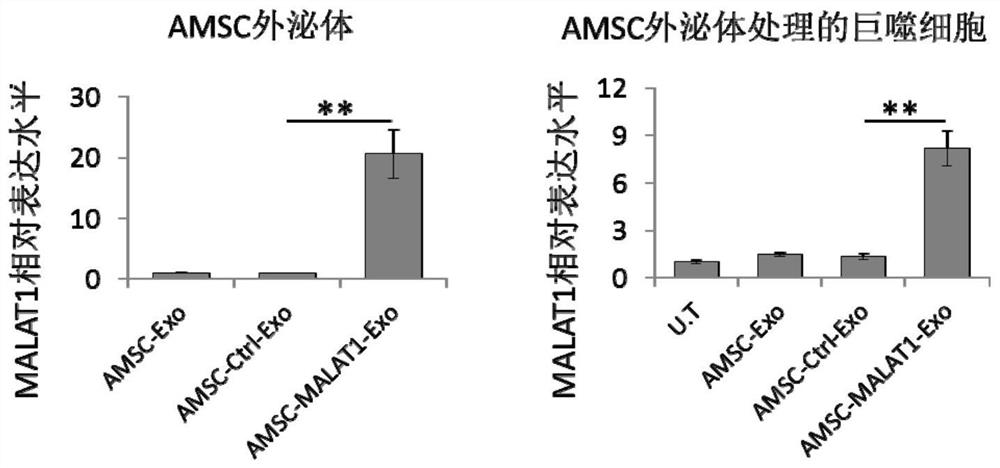Application of amsc-malat1-exo in the preparation of medicines for treating liver diseases and its preparation method
A liver disease and drug technology, which is applied in the preparation of liver disease treatment biological preparations, the construction of adipose-derived mesenchymal stem cells and the preparation of exosomes, and the application fields of liver macrophage targeting biological preparations, which can solve the problem of difficult mass preparation. , the limitation of preparation technology, etc., to achieve the effect of reducing the required amount, reducing the effective dose, and improving the treatment effect of liver diseases
- Summary
- Abstract
- Description
- Claims
- Application Information
AI Technical Summary
Problems solved by technology
Method used
Image
Examples
Embodiment 1
[0070] Example 1 AMSC-MALAT1-Exo can mediate the transfer of MALAT1 to macrophages
[0071] qRT-PCR analysis of MALAT1 was performed as described above. Such as figure 1 As shown on the left, AMSC-MALAT1-Exo contains high levels of MALAT1.
[0072] AMSC-MALAT1-Exo, AMSC-Ctrl-Exo, and native AMSC-Exo were added to macrophage RAW264.7, and the cells were collected after 24 hours for qPCR analysis of MALAT1 levels.
[0073] qPCR results showed that AMSC-MALAT1-Exo could significantly up-regulate the MALAT1 level of macrophages compared with AMSC-Ctrl-Exo and native AMSC-Exo ( figure 1 right).
Embodiment 2
[0074] Example 2 AMSC-MALAT1-Exo regulates macrophage phenotype
[0075] Add gradient concentrations of AMSC-MALAT1-Exo, AMSC-Ctrl-Exo and native AMSC-Exo (0.2 μg / mL, 4 μg / mL, 80 μg / mL) to macrophage RAW264.7, and add corresponding volume of PBS as In the control group (Vehicle), the cells were collected after 24 hours for qPCR analysis of macrophage phenotype-related molecules.
[0076] Compared with AMSC-Ctrl-Exo and natural AMSC-Exo, AMSC-MALAT1-Exo can more significantly up-regulate the expression of molecules related to M2 phenotype of macrophages Arg1 and Fizz-1, while down-regulate the expression of M1 phenotype under the same concentration conditions Expression of related molecules CD86 and iNOS. AMSC-MALAT1-Exo can significantly affect the expression of M1 / 2 phenotype-related molecules at a concentration of 0.2 μg / mL, while AMSC-Ctrl-Exo and native AMSC-Exo can significantly regulate the M1 / 2 phenotype at a concentration of 80 μg / mL Expression of related molecules (...
Embodiment 3
[0077] Example 3 AMSC-MALAT1-Exo regulates the secretion of macrophage inflammatory factors
[0078] Macrophages RAW264.7 were treated with gradient concentrations of AMSC-MALAT1-Exo, AMSC-Ctrl-Exo and natural AMSC-Exo (0.2 μg / mL, 4 μg / mL, 80 μg / mL) for 24 hours, and corresponding volumes of PBS was used as the control group (Vehicle); and then stimulated with LPS (100ng / mL) for 12h, and then ELISA was used to detect the levels of IL-1β, IL-33 and HMGB1 in the cell supernatant.
[0079] Under the same concentration conditions, AMSC-MALAT1-Exo can more significantly reduce the secretion of LPS-induced macrophage inflammatory factors IL-1β, IL-33 and HMGB1 than AMSC-Ctrl-Exo and natural AMSC-Exo. AMSC-MALAT1-Exo can significantly inhibit the secretion of macrophage inflammatory factors at a concentration of 0.2 μg / mL, and its inhibitory effect is comparable to that of AMSC-Ctrl-Exo and natural AMSC-Exo at a concentration of 80 μg / mL ( image 3 ).
[0080] Moreover, the AMSC-Ex...
PUM
 Login to View More
Login to View More Abstract
Description
Claims
Application Information
 Login to View More
Login to View More - R&D
- Intellectual Property
- Life Sciences
- Materials
- Tech Scout
- Unparalleled Data Quality
- Higher Quality Content
- 60% Fewer Hallucinations
Browse by: Latest US Patents, China's latest patents, Technical Efficacy Thesaurus, Application Domain, Technology Topic, Popular Technical Reports.
© 2025 PatSnap. All rights reserved.Legal|Privacy policy|Modern Slavery Act Transparency Statement|Sitemap|About US| Contact US: help@patsnap.com



